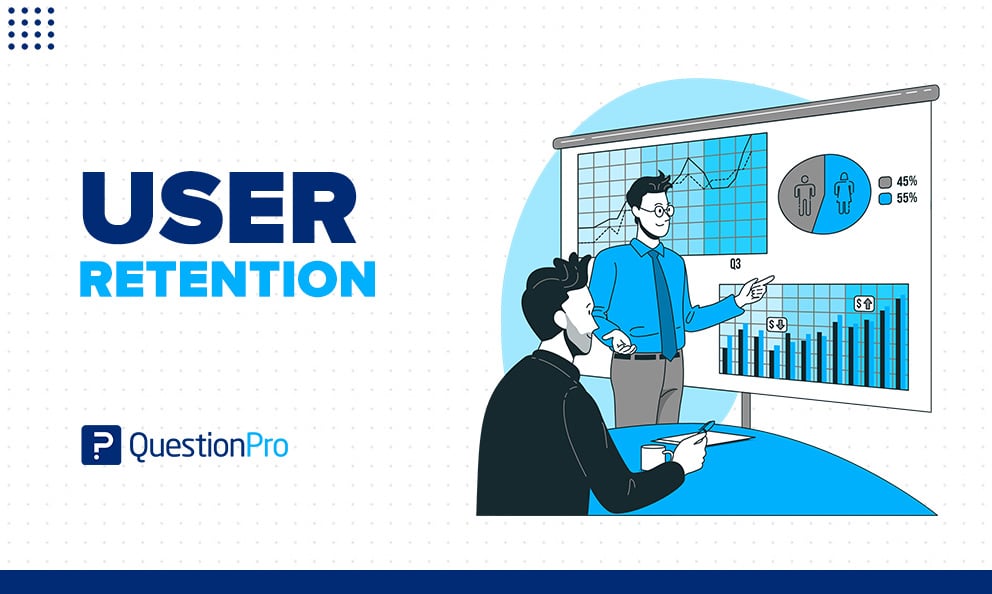 Reading Time: 4 minutes read
Reading Time: 4 minutes read
User retention is an important indicator for any product. It gives you an idea of how successfully your product attracts users’ attention. Measuring retention allows you to build a loyal user base and increase income. If you track this statistic, you’ll know when you need to make big changes or shift your strategy to meet your development objectives.
Retention of users is a trustworthy, legitimate, and reliable behavioral assessment. The key to retaining loyal users and winning long-term subscriptions, renewals, and referrals is to create a product that gives actual value in a simple, pleasant way. You need to understand the concept and how to measure it.
LEARN ABOUT: Time to Value
What is user retention?
User retention is the continuing use of a product or feature. It’s an important indicator for measuring the success of SaaS and digital products. It measures the percentage of first-time users who return in successive periods.
You can analyze your retention of users regularly or look into a specific time. If you’re studying the retention of users for your product, you can look at the number of logins over time.
Customer retention and customer turnover are not the same as user retention. Let’s examine the differences.
User retention vs. customer retention: what’s the difference?
Retention of users and customer retention are practically the same for consumer companies because the individual user is also the one who often pays for the service. These are two terms that are related but not the same. Customer retention only considers customers who pay for your product regularly, but user retention considers anyone who uses it frequently. You’ll be monitoring customer retention rather than the retention of users if you provide a paid service.
User retention vs. customer turnover: what’s the difference?
Customer turnover is the number of clients you’ve lost in a given period. This is the inverse of your customer retention. Retention defines how many users remain to a product during a certain timescale, whereas turnover measures how many people stop using a product within that same time range. A high churn rate indicates that your users are unhappy with your products or services. This indicates that your product isn’t meeting your client’s needs.
Phases of user retention
The majority of user churn occurs within the first three months. Users go through three stages throughout this time: onboarding, activation, and habitual use. Ensure that each phase provides a streamlined, enjoyable user experience to maintain a high percentage of retained users.
Onboarding
User retention begins with a smooth onboarding process. First-time users sign up and become familiar with your products or services during onboarding. Creating a smooth and easy new user onboarding experience can help users move to the next phase faster. It also provides an opportunity to direct visitors’ attention to the most important features. The user’s interest will be lost if the process is too complicated or confusing.
Activation
After onboarding, activation is the stage at which your users realize the value of your product. Users can recognize how your product will help them with their daily activities. Active users are more likely to remain loyal to your product.
Habitual Use
The last step in maintaining users is to create usage habits. During this stage, users believe the product is necessary. Users become personally involved in the product to use it and make it a part of their daily routine.
The importance of user retention analysis
Measuring the retention of users can help you determine if your product and market are a good fit. Failure to retain users leads to a financial loss for every new business acquisition. A company can only benefit from each customer if they keep their users after the payback period. This indicates that users are staying for the long term and that your audience’s needs are being addressed.
How do you measure user retention?
User retention rate can be calculated by dividing the number of active users in a given time by the number of users in the previous period. It is simple to measure the retention of users when you have chosen a specific time period. The complete formula for calculating user retention rate is as follows:
User Retention: (Number of active users over time / Total Number of active users in the previous period ) x 100

Assume that 2000 people downloaded a mobile game. After one day, 400 people played the game. After a week, only 200 people used it. After one month, there were just 100 players who remained in the game. In this case, the retention rates are as follows:
- 20% retention after one day.
- 10% retention after a week.
- 5% retention after one month.
Conclusion
User retention needs to be monitored on a regular basis. You may track the retention of users throughout the lifecycle of your product or service at any given time. It will provide you with insight into your customers’ thoughts. This data can also be used to evaluate the effectiveness of various advertising campaigns or customer acquisition tactics.
LEARN ABOUT: Customer Lifecycle
QuestionPro CX is a customer experience management platform that provides you with a variety of solutions to figure out where your customers’ experiences are lacking. By carefully listening to customer feedback and applying the appropriate data, you can give a pleasant CX experience to current and future customers. Try QuestionPro today!







